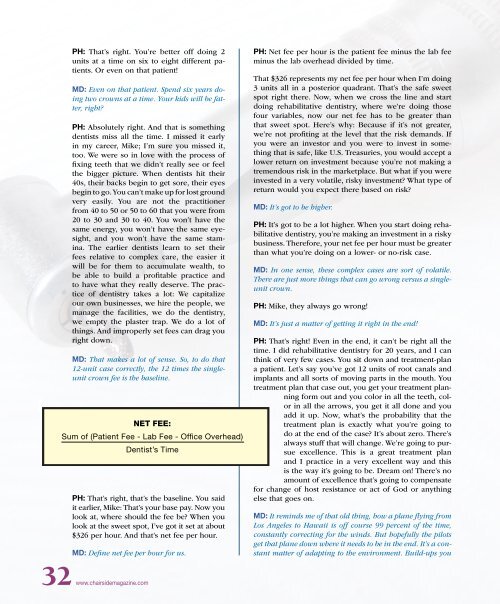PDF Version - Glidewell Dental Labs
PDF Version - Glidewell Dental Labs
PDF Version - Glidewell Dental Labs
Create successful ePaper yourself
Turn your PDF publications into a flip-book with our unique Google optimized e-Paper software.
PH: That’s right. You’re better off doing 2<br />
units at a time on six to eight different patients.<br />
Or even on that patient!<br />
MD: Even on that patient. Spend six years doing<br />
two crowns at a time. Your kids will be fatter,<br />
right?<br />
PH: Absolutely right. And that is something<br />
dentists miss all the time. I missed it early<br />
in my career, Mike; I’m sure you missed it,<br />
too. We were so in love with the process of<br />
fixing teeth that we didn’t really see or feel<br />
the bigger picture. When dentists hit their<br />
40s, their backs begin to get sore, their eyes<br />
begin to go. You can’t make up for lost ground<br />
very easily. You are not the practitioner<br />
from 40 to 50 or 50 to 60 that you were from<br />
20 to 30 and 30 to 40. You won’t have the<br />
same energy, you won’t have the same eyesight,<br />
and you won’t have the same stamina.<br />
The earlier dentists learn to set their<br />
fees relative to complex care, the easier it<br />
will be for them to accumulate wealth, to<br />
be able to build a profitable practice and<br />
to have what they really deserve. The practice<br />
of dentistry takes a lot: We capitalize<br />
our own businesses, we hire the people, we<br />
manage the facilities, we do the dentistry,<br />
we empty the plaster trap. We do a lot of<br />
things. And improperly set fees can drag you<br />
right down.<br />
MD: That makes a lot of sense. So, to do that<br />
12-unit case correctly, the 12 times the singleunit<br />
crown fee is the baseline.<br />
NET FEE:<br />
Sum of (Patient Fee - Lab Fee - Office Overhead)<br />
Dentist’s Time<br />
PH: That’s right, that’s the baseline. You said<br />
it earlier, Mike: That’s your base pay. Now you<br />
look at, where should the fee be? When you<br />
look at the sweet spot, I’ve got it set at about<br />
$326 per hour. And that’s net fee per hour.<br />
MD: Define net fee per hour for us.<br />
PH: Net fee per hour is the patient fee minus the lab fee<br />
minus the lab overhead divided by time.<br />
That $326 represents my net fee per hour when I’m doing<br />
3 units all in a posterior quadrant. That’s the safe sweet<br />
spot right there. Now, when we cross the line and start<br />
doing rehabilitative dentistry, where we’re doing those<br />
four variables, now our net fee has to be greater than<br />
that sweet spot. Here’s why: Because if it’s not greater,<br />
we’re not profiting at the level that the risk demands. If<br />
you were an investor and you were to invest in something<br />
that is safe, like U.S. Treasuries, you would accept a<br />
lower return on investment because you’re not making a<br />
tremendous risk in the marketplace. But what if you were<br />
invested in a very volatile, risky investment? What type of<br />
return would you expect there based on risk?<br />
MD: It’s got to be higher.<br />
PH: It’s got to be a lot higher. When you start doing rehabilitative<br />
dentistry, you’re making an investment in a risky<br />
business. Therefore, your net fee per hour must be greater<br />
than what you’re doing on a lower- or no-risk case.<br />
MD: In one sense, these complex cases are sort of volatile.<br />
There are just more things that can go wrong versus a singleunit<br />
crown.<br />
PH: Mike, they always go wrong!<br />
MD: It’s just a matter of getting it right in the end!<br />
PH: That’s right! Even in the end, it can’t be right all the<br />
time. I did rehabilitative dentistry for 20 years, and I can<br />
think of very few cases. You sit down and treatment-plan<br />
a patient. Let’s say you’ve got 12 units of root canals and<br />
implants and all sorts of moving parts in the mouth. You<br />
treatment plan that case out, you get your treatment planning<br />
form out and you color in all the teeth, color<br />
in all the arrows, you get it all done and you<br />
add it up. Now, what’s the probability that the<br />
treatment plan is exactly what you’re going to<br />
do at the end of the case? It’s about zero. There’s<br />
always stuff that will change. We’re going to pursue<br />
excellence. This is a great treatment plan<br />
and I practice in a very excellent way and this<br />
is the way it’s going to be. Dream on! There’s no<br />
amount of excellence that’s going to compensate<br />
for change of host resistance or act of God or anything<br />
else that goes on.<br />
MD: It reminds me of that old thing, how a plane flying from<br />
Los Angeles to Hawaii is off course 99 percent of the time,<br />
constantly correcting for the winds. But hopefully the pilots<br />
get that plane down where it needs to be in the end. It’s a constant<br />
matter of adapting to the environment. Build-ups you<br />
32 www.chairsidemagazine.com

















